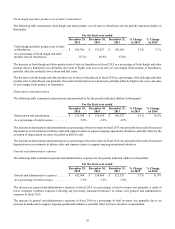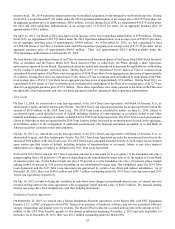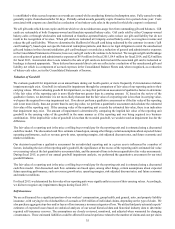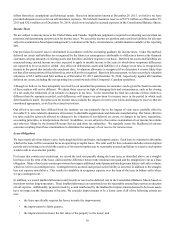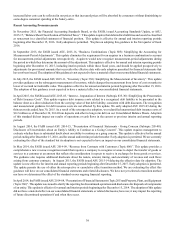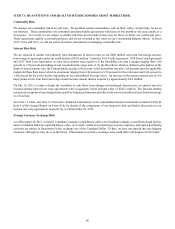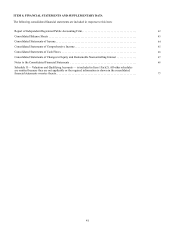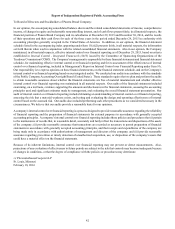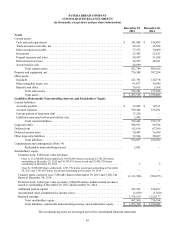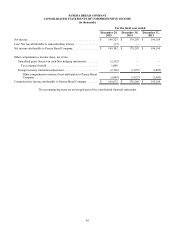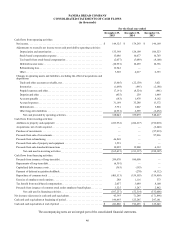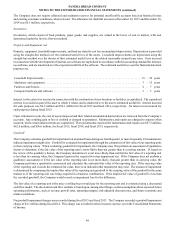Panera Bread 2015 Annual Report Download - page 49
Download and view the complete annual report
Please find page 49 of the 2015 Panera Bread annual report below. You can navigate through the pages in the report by either clicking on the pages listed below, or by using the keyword search tool below to find specific information within the annual report.39
increased labor costs can be reflected in our prices or that increased prices will be absorbed by consumers without diminishing to
some degree consumer spending at the bakery-cafes.
Recent Accounting Pronouncements
In November 2015, the Financial Accounting Standards Board, or the FASB, issued Accounting Standards Update, or ASU,
2015-17, “Balance Sheet Classification of Deferred Taxes”. This update requires that deferred tax liabilities and assets be classified
as noncurrent in a classified statement of financial position. This update is effective for annual and interim reporting periods
beginning after December 15, 2016. Early adoption is permitted. We plan on adopting this guidance in the first quarter of fiscal
2016.
In September 2015, the FASB issued ASU, 2015-16, “Business Combinations (Topic 805): Simplifying the Accounting for
Measurement-Period Adjustments”. This update eliminates the requirement for an acquirer in a business combination to account
for measurement-period adjustments retrospectively. Acquirers would now recognize measurement-period adjustments during
the period in which they determine the amount of the adjustment. This update is effective for annual and interim reporting periods
beginning after December 15, 2015, including interim periods within those fiscal years, and should be applied prospectively to
adjustments for provisional amounts that occur after the effective date with early adoption permitted for financial statements that
have not been issued. The adoption of this guidance is not expected to have a material effect on our consolidated financial statements.
In July 2015, the FASB issued ASU 2015-11, “Inventory (Topic 330): Simplifying the Measurement of Inventory”. This update
provides guidance on the subsequent measurement of inventory, which changes the measurement from lower of cost or market to
lower of cost and net realizable value. This update is effective for annual and interim periods beginning after December 15, 2016.
The adoption of this guidance is not expected to have a material effect on our consolidated financial statements.
In April 2015, the FASB issued ASU 2015-03, “Interest – Imputation of Interest (Subtopic 835-30): Simplifying the Presentation
of Debt Issuance Costs”. This update requires debt issuance costs related to a recognized debt liability to be presented in the
balance sheet as a direct deduction from the carrying value of that debt liability, consistent with debt discounts. The recognition
and measurement guidance for debt issuance costs are not affected by this update. We early adopted ASU 2015-03 during the
thirteen weeks ended June 30, 2015. As a result of the retrospective adoption, we reclassified unamortized debt issuance costs of
$0.2 million as of December 30, 2014 from deposits and other to long-term debt on our Consolidated Balance Sheets. Adoption
of this standard did not impact our results of operations or cash flows in the current or previous interim and annual reporting
periods.
In August 2014, the FASB issued ASU 2014-15, “Presentation of Financial Statements - Going Concern (Subtopic 205-40):
Disclosure of Uncertainties about an Entity’s Ability to Continue as a Going Concern”. This update requires management to
evaluate whether there is substantial doubt about our ability to continue as a going concern. This update is effective for the annual
period ending after December 15, 2016, and for annual and interim periods thereafter. Early adoption is permitted. We are currently
evaluating the effect of the standard but its adoption is not expected to have an impact on our consolidated financial statements.
In May 2014, the FASB issued ASU 2014-09, “Revenue from Contracts with Customers (Topic 606)”. This update provides a
comprehensive new revenue recognition model that requires a company to recognize revenue to depict the transfer of goods or
services to a customer at an amount that reflects the consideration it expects to receive in exchange for those goods or services.
The guidance also requires additional disclosure about the nature, amount, timing, and uncertainty of revenue and cash flows
arising from customer contracts. In August 2015, the FASB issued ASU 2015-14 delaying the effective date for adoption. The
update is now effective for interim and annual reporting periods beginning after December 15, 2017. Early adoption is permitted.
The update permits the use of either the retrospective or cumulative effect transition method. We are evaluating the effect this
guidance will have on our consolidated financial statements and related disclosures. We have not yet selected a transition method
nor have we determined the effect of the standard on our ongoing financial reporting.
In April 2014, the FASB issued ASU 2014-08, “Presentation of Financial Statements (Topic 205) and Property, Plant, and Equipment
(Topic 360)”. This update was issued to clarify the reporting for discontinued operations and disclosures for disposals of components
of an entity. This update is effective for annual and interim periods beginning after December 15, 2014. The adoption of this update
did not have a material effect on our consolidated financial statements or related disclosures; however, it may impact the reporting
of future discontinued operations if and when they occur.


